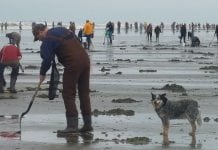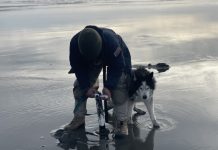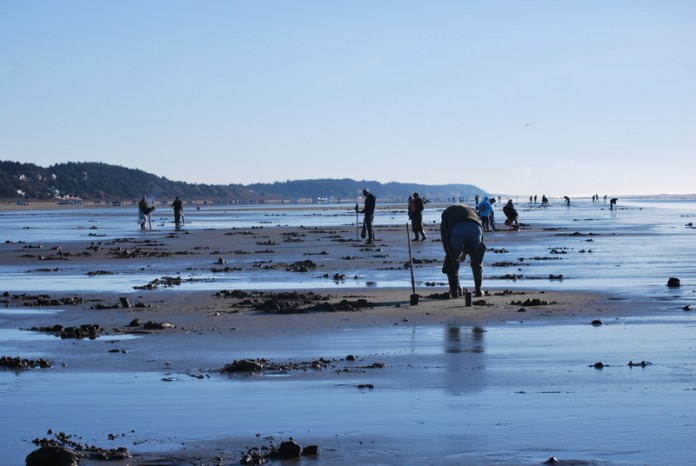By Rachel Ayres, Montesano High School Intern

Dressed in the full attire of Northwest outdoorsmen, they brave the weather to claim the golden shelled prize. Waking up early, or lighting a lantern for the evening, tens of thousands of people search the Pacific sand for the alerting clam show. With adrenaline rushing through the blood, down into the sand they dig to find the treasured razor clam.
In the Pacific Northwest, and especially the Grays Harbor area, many people grow up razor clam digging. Most others in the world don’t discuss when they got their first razor clam limit, when they learned to dig with a shovel, or when they got a clam that was “this big!” But here in Grays Harbor, we do; it is unique.
I am like many others in Grays Harbor; I grew up clamming. Next to pictures of my first day of preschool are photos of me and a clam tube that was just about as tall as I was. For my family and many others, it is a long standing tradition to harvest these local specialties.
The razor clam is defined as “a burrowing bivalve mollusk with a long, slender shell that resembles an old fashioned straight razor.” Since the beginning of the 20th century in Washington State, razor clam digging was a commercial fishery as well as a fun harvesting pastime. But, even before those days, many Native American tribes of this area harvested the meaty shellfish. The dimpled shows in the sand have provided the route for coastal food for people who lived in our area for thousands of years.
For those who don’t know, my dad, Dan Ayres (aka the “Clam Man”) is the lead coastal shellfish biologist with the Washington State Department of Fish and Wildlife. His job is about as unique as his field, and allows him to work out on the beach, out of his office, and sometimes somewhere else alltogether during the occasional work trip. You might be jealous, but keep in mind that part of the deal includes having to listen to stories of clam diggers and the razor clam life cycle around the family dinner table.
Like most of the long time Harborites, my dad has memories clam digging “back in the day.” Growing up in Aberdeen, my dad and grandpa would drive out to the beaches in the early morning hours to get their limits for grandma to cook for dinner that night.

“It is a big deal for the community,” he said last week while driving over the Aberdeen Bluff, which took 20 minutes thanks to clam traffic. Many people come from all over Washington and the rest of the world to get their limit. The large number of people that clam digging attracts to Grays Harbor also brings in a good chunk of change. A portion of the economy is centered around that, with many business in the community benefiting. For an average season, $22 million dollars of clam digger- and tourist-related income is generated, while on a great season, like the 2013–2014 one, that number is $39 million.
But, the “Clam Man” doesn’t do it all. Every time there are clam tides, he and his colleagues count the people, interview some of the diggers, and check for wastage as part of collecting data to determine daily harvest on each beach. In the off season months of June through September, he and his crew are busy with population assessments, “seeing how many are left and how they have grown.” This information helps to determine the new season.
Between the five beaches—Long Beach, Twin Harbors, Copalis, Mocrocks, and Kalaloch—there are 58 miles of razor clam habitat. Dad knows about every inch of those beaches from all of the years of working on them. For some, going to the beach is a relaxing vacation, but for him it is like going to work.
Growing up clam digging has made me a total fan. I love going out to the beach with a shovel in hand to get dirty and to get dinner. I never turn down an invitation to the beach, and I always eat my whole bowl of chowder and clam fritters. I have many great memories growing up digging, always ending our dig with a snack and hot cocoa. Vividly, I can still remember the first time I proudly got my limit all by myself. Also, I can recall all of the times where, out in the cold and rain, my fingers would be cold enough to the point where I couldn’t seal my tube.

Razor clam digging is one of my favorite recreational activities because of the hard work that goes in and the big reward that comes out, but also for the positive economic and social benefits it offers my community.
To celebrate the razor clam and the culture of the people, two large specific festivals happen each year. The Ocean Shore Razor Clam Festival & Seafood Extravaganza, put on by the Ocean Shores/North Beach Chamber of Commerce, is set for March 20–22. Then on April 18 and 19, the Long Beach Razor Clam Festival, sponsored by the Dennis Company, will also be held. With activities and events such as chowder competitions, vendors, live music, demonstrations, stuff for kids, and oh so much more, both festivals are great opportunities to experience more of Grays Harbor’s razor clam culture. To find out more information about the two festivals, visit longbeachrazorclamfestival.com and the Ocean Shores/North Beach Chamber of Commerce’s website here.












































